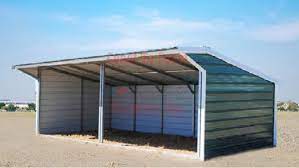 Loafing Shed Plans
Loafing Shed Plans
Do you want the absolute best for your horses? If so, installing a loafing shed can provide them with a variety of benefits, including shelter from the weather, a place to rest, and even a way to get a quick snack or drink of water. However, when it comes to building structures such as these, loafing shed plans are essential for making sure everything goes accordingly.
Why is this? While there are many builders who have the budget, patience, and experience to build loafing sheds from scratch using their own plans, the truth of the matter is that most horse owners aren’t professional carpenters or builders. If you want to craft your own loafing shed, it’s a good idea to have an outline to work by. Otherwise, you run the risk of courting disaster.
Keep your horses comfortable
Why is this? It may seem silly to treat something as simple as a loafing shed in such a way, but any horse owner knows that horses are unpredictable. You never know what may happen. Having a poorly built loafing shed may result in your horses being uncomfortable and temperamental at the least. At worst, your horses can actually hurt themselves. For this reason alone, you should strive to get the best loafing shed plans possible.
Fortunately, there is a wide variety of loafing shed plans to choose from. However, therein lies a problem, as there are so many different designs and plans available that finding the right one for your unique situation may be difficult. This is why, before choosing your loafing shed plans, you should keep your surroundings and your horses in mind.
Why is this? If your environment is prone to lots of rain and cold, damp weather, for example, choosing wood as materials for your loafing shed might not be ideal. If a horse should kick or trample one of the walls, you may discover the wood is sodden, rotten, or even infested with insects. Worse still, the horse may end up hurting its legs by kicking holes in the weak wood. Similarly, you should only choose strong, durable metals for your loafing shed, as at best they may dent under your horse’s hooves.
In addition to this, you should only arrange your loafing shed plans on the ground that is dry and firm. This is why so many plans recommend building your shed in areas where water can run away from the structure, preventing puddling or excessive muddiness.
Learn more about loafing shed plans today and how they can make your project go much smoother!
Small Loafing building plans or a small horse barn?
A loafing shed is a type of shed that is designed to provide shelter for animals. This is typically an open-air shed with a roof and open sides to allow the animals to freely enter and exit at will. A loafing shed is typically constructed with a wooden frame and then covered with a type of siding material.
Building plans include a door, roof, walls, and size boards
This type of shed is often used for animals such as horses, goats, and sheep. The design of the loafing shed is typically rectangular in shape with a sloping roof. The roof typically starts from the ground and slopes upward to a peak at the center. One side of the shed is typically left open so that animals can come and go as they please.
Loafing building plans are more popular for your horse
A loafing building has many benefits for both the animals and the owner. The shed allows the animals to stay out of the sun and rain and provides shelter.
It also provides the animals with warmth to protect them from the winter weather. The shed can also be used as a place to store hay and other feed items. The loafing shed is a great alternative to a barn, which many people find more convenient and affordable. A loafing shed can also be used to keep your cattle under a roof.
A loafing shed is a type of shed or shelter for farm animals. It is typically used for the animals to rest or spend the night. This type of shed is typically built near the barn.



Thanks for the useful article! I recently bought a horse property and now am thinking about a horse shed addition. It’s quite a challenge to choose the right one (materails, cost, delivery, etc)